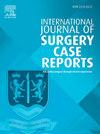Nonfunctioning paraganglioma of the bladder mimicking nested variant of urothelial cancer: A case report and clinical management
IF 0.6
Q4 SURGERY
引用次数: 0
Abstract
Introduction and importance
Non-functioning paraganglioma of the bladder is extremely rare disease. It is important to know the presence of paraganglioma of the bladder as the early and correct diagnosis affects the management and prognosis of the patient. Pathologists may misinterpret it as part of cystitis cystica/glandularis or nested variant urothelial carcinoma, or secondary bladder involvement by prostatic adenocarcinoma.
This report will contribute to the existing literature and provide valuable insights into the clinical characteristics and treatment options for this rare tumor.
Presentation of case
35 years old female patient presented after incidental finding of bladder mass on abdominal ultrasound during routine antenatal follow up. Cystoscope showed 2 × 2 cm single solid bladder mass. Microscopic examination was suggestive of neuroendocrine tumor with paragangliom as a differential diagnosis. Imminohistochemical studies showed positive for synaptophysin, S100, GATA-3 and negative for panCK. The patient was managed with partial cystectomy.
Clinical discussion
Non-functioning paragnaglioma of the urinary bladder is a rare extra-adrenal pheochromocystoma. The diagnosis is usually challenging and it may mimic urothelial carcinoma. Histopathology and immunohistochemistry are almost always confirmatory.
Conclusion
Urinary bladder paraganglioma may mimic nested variant of the bladder tumor. High clinical suspicion is important. Confirmation is with histopathology and immunohistochemistry. Partial cystectomy is treatment of choice.
导言和重要性膀胱非功能性副神经节瘤是一种极为罕见的疾病。了解膀胱副神经节瘤的存在非常重要,因为早期正确诊断会影响患者的治疗和预后。病理学家可能会将其误诊为膀胱炎/膀胱腺病或巢状变异性尿路上皮癌的一部分,或继发于前列腺腺癌的膀胱受累。本报告将为现有文献做出贡献,并为这一罕见肿瘤的临床特征和治疗方案提供有价值的见解。膀胱镜显示 2 × 2 厘米单个实性膀胱肿块。显微镜检查提示为神经内分泌肿瘤,并与副神经节瘤进行了鉴别诊断。免疫组织化学检查显示突触素、S100、GATA-3阳性,panCK阴性。临床讨论膀胱非功能性副神经胶质瘤是一种罕见的肾上腺外嗜铬细胞瘤。膀胱非功能性副嗜铬细胞瘤是一种罕见的肾上腺外嗜铬细胞瘤,其诊断通常具有挑战性,并可能与尿路上皮癌相似。组织病理学和免疫组化几乎总是可以确诊。临床高度怀疑非常重要。组织病理学和免疫组化是确诊的关键。膀胱部分切除术是首选治疗方法。
本文章由计算机程序翻译,如有差异,请以英文原文为准。
求助全文
约1分钟内获得全文
求助全文
来源期刊
CiteScore
1.10
自引率
0.00%
发文量
1116
审稿时长
46 days

 求助内容:
求助内容: 应助结果提醒方式:
应助结果提醒方式:


